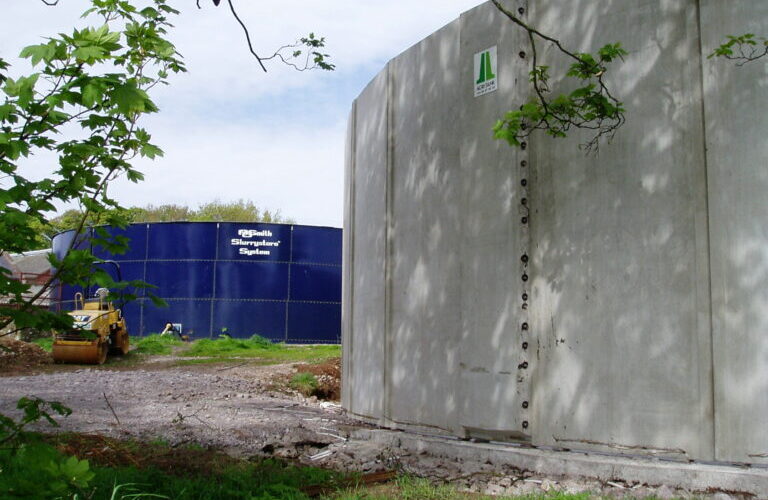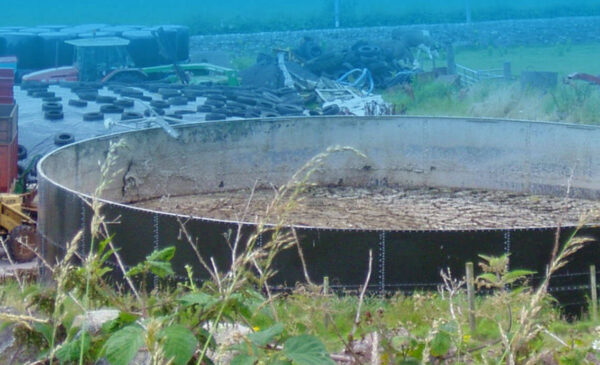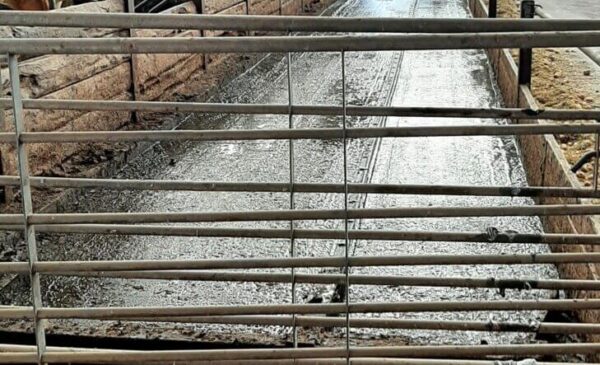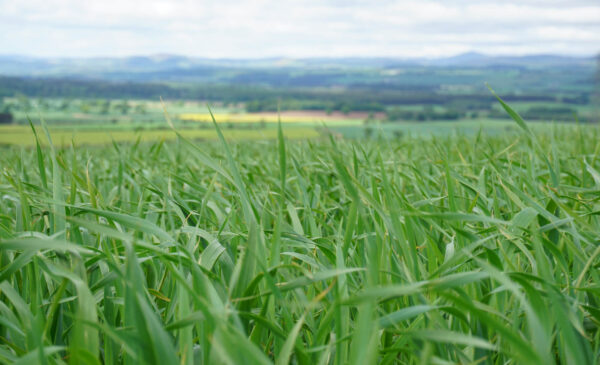Farms producing slurry must have adequate facilities and management in place to collect, store and manage slurry and other products, which have the potential to pollute the environment if mis-managed. For dairy units, dairy washings and parlour drainage must also be collected and contained within the farm slurry storage system.
Farms must have capacity to store the total quantity of slurry likely to be produced in 22 weeks by housed cattle, or 26 weeks for housed pigs. This capacity must also be sufficient to capture and store any rainwater entering the system, this includes from the farm steading where there is a reasonable expectation of contamination with slurry, from dirty yards, silage pits and from parlour washings.
All storage structures, whether these be below ground storage, slurry tower or lagoon, must;
- Be maintained to ensure they are kept free from any structural defects.
- Be fit for purpose and meet a minimum level of structural integrity such that;
- The base and walls of any channel, reception pit, the walls of any pipe and the base of any tank are impermeable.
- The walls of any tank are impermeable unless the base of the tank extends beyond its walls and has channels to collect and transfer any escaped slurry to a slurry storage system.
- Where slurry flows into a channel before discharging into a reception pit and is controlled by a sluice or valve, the reception pit has adequate capacity to contain the maximum slurry that can be released by opening the sluice or valve.
- The capacity of any facility used to temporarily store slurry before transferring to the slurry tank must have the equivalent of at least 1.5% of the minimum farm storage capacity.
- Where the slurry storage tank is fitted with a drainage pipe, there are two valves fitted in series that are to be kept locked shut when not in use.
- Earth bank lined
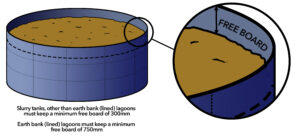 lagoons maintain a minimum freeboard of 750 mm and all other slurry tanks maintain a minimum freeboard of 300 mm.
lagoons maintain a minimum freeboard of 750 mm and all other slurry tanks maintain a minimum freeboard of 300 mm.
Further information
- Read our Know the Rules Factsheet 1 – slurry and manure storage.
- Consider ideas to reduce dirty water production around the steading.
- You can review the full list of regulations relating to the storage of slurry in light of protection of the water environment are in GBR 32 (Storage of Slurry) in the CAR PracticalGuide.
All farms which produce slurry, must have sufficient storage capacity to contain slurry from a minimum 22 week housed period for cattle or 26 weeks for housed pigs.”
Storage capacity must take account of rainfall entering the system, this could include via middens, dirty yards, silage clamps, any dairy or parlour washings and any slurry brought onto farm for any reason. All farms located outside of an established Nitrate Vulnerable Zone will need to comply with minimum storage requirements by 1st January 2026.
To calculate minimum storage capacity, the farm should take account of:
- Slurry production directly from housed livestock – standard figures are available in NVZ guidance Section 5 Manure Planning Part 2: Livestock Manure Storage.
- Rainfall entering the system, both direct and via run-off from dirty yards, middens and silage clamps – Scottish Rainfall Data is available via the SEPA website – select the closest location on map and use monthly mean data from line graph.
- Any washings or dairy wash water.
- Any slurry imported or exported from the farm.
- Space required for freeboard – all earthbank lined lagoons must incorporate a 750 mm freeboard and all other tanks must include a 300 mm freeboard.
Further information
- Read our Know the Rules Factsheet 1 – slurry and manure storage.
- Estimate slurry production from housed livestock.
- Consider ideas to minimise dirty water production around the steading.
- Calculate slurry storage space – watch the Farming and Water Scotland webinar.
- Use the slurry storage calculator, available on the Rural Payments website.
There are a number of different options for slurry storage. Choice will depend on the type and volume of the material to be stored, topography and ground conditions, site/location available, maintenance considerations, access and cost.
If you are planning to install a new slurry storage system or substantially reconstruct or enlarge any existing system you must consult with a suitably qualified engineer, have an engineering plan available for the proposed works and retain the engineers final sign-off certificate for the works for the life of the structure. It may also be worth checking with your local council in terms of any planning restrictions.
Farmers planning a new slurry store or silage structure on the farm, or significantly altering an existing silage or slurry structure, must notify SEPA 30 days prior to starting any development work.
All slurry storage options must be sited at least 10 m from a surface water or surface drain. For those considering constructing a slurry store Table 1.3 lists the different slurry storage types most often considered and outlines some of the pros and cons to be aware of.
Further information
- Review the Know the Rules Factsheet 1 – Slurry and manure storage.
- Know the Rules Factsheet 2 – Maintaining slurry storage systems.
- Notify SEPA of new/substantially enlarged slurry system via this form.
- Watch the ‘Managing slurry for folks in a hurry’ Farming and Water Scotland webinar series.
Table 1.3 Slurry store options
| Structure | Outline | Pros | Cons |
| Slurry lagoon | Lined, above or below ground structure.Lining must be impermeable to prevent loss of contents.
Should have a design life of 20 years with proper maintenance. Requires a 750 mm freeboard. Can be covered; covering the lagoon at build stage will be cheaper than a retrofit cover at a later date. May require a leak detection system. |
Cost effective when compared to a steel or concrete store.Easy to make a visual check of slurry level | Open tank – will collect rainwater taking up slurry storage space plus larger surface area will release more emissions to air please see slurry store covers tabLiner can be a weak point – limited lifespan requires protection of liner at mixing and filling points. Depending on how lagoon is emptied this area might also need protection.
May need protection from burrowing animals. Can be difficult to mix slurry due to the size of lagoon. Not suitable for areas with high water table as can float the liner. |
| Above ground tanks/towers | Steel or concrete structures built on an impermeable base with reception pit and pumps to transfer slurry.Requires a 300 mm freeboard.
Can be covered; covering the tank at build will be cheaper than a retrofit cover at a later date. |
Less land needed in comparison to a lagoon.Smaller surface area for collection of rainwater in comparison to a lagoon
Tank can be covered to reduce ammonia losses and retain more nitrogen. Storage space can be extended. Easy and cost effective to maintain |
Slurry has to be pumped; not suitable for material with high dry matter content.Mechanical pumps and valves will need servicing and maintenance.
More costly than an earth bank liner lagoon /m3 of slurry. |
| Slatted stores | Store sited underneath the livestock building. Can contain a mix of manures and slurry, depending on the amount of rainfall getting into the system. | If located in a building rainfall is excluded. | Maintenance and operation in an enclosed space – high risk of hazardous gas. |
| Weeping wall systems | Store consists of a concrete floor with one or more semi-permeable walls. The solid fraction is kept within the store, whilst the liquid is able to drain into a collection system.Solids can be removed using a ramp, lift out panels or excavator. | May be easier to handle, as structure separates slurry into a solid and liquid fraction.With maintenance, can provide a long-lasting slurry storage option.
|
The liquid collected from the weeping wall is classified as slurry.Not always the most cost-effective storage option.
|
| Slurry bags | Slurry bags are impermeable, refillable bags for holding slurry.They need to be sited in a lined impermeable bund with a mechanism to remove rainwater from the bund – any valve or pipe installed for this purpose shouldn’t penetrate the bund.
May require a leak detection system.
|
Will reduce ammonia emissions, therefore, nitrogen loss during storage.Excludes rainwater. | Needs to be sited in a lined impermeable bund i.e. a lined lagoon.Only suitable for pumpable slurry.
Not suitable for areas with high water table as can float the bag. Bag vulnerable to damage by machinery/animals. Disposal/recycling at end of life. |
| Steading/yard middens | Manure stores, dungsteads and middens can be used to store stackable manure. Effluent from middens is classed as slurry and must be collected. | Covering the midden will reduce rain driven runoff.Rain driven runoff may be diverted to a constructed farm wetland. | Not suitable for slurry or semi-solid manures. |
Drainage from yard middens should be collected and added to the slurry collection system. Alternatively, rainfall driven lightly contaminated runoff from middens can be put to a constructed farm wetland for treatment.
Where practical, if the yard midden can be roofed it will reduce rainfall running through the midden and cut down on both dirty water production and nutrient losses.
Temporary field middens must not be sited on waterlogged or shallow soils or within 10 m of any ditch, burn, river, loch, wetland or coastal water. On sloping ground, a wider buffer zone may be required to prevent runoff getting into a watercourse. Water that could be used for domestic supply also needs protecting; for this reason field heaps must not be sited within 50 m of any spring that supplies water for human consumption or any uncapped well or borehole.
In NVZ’s, temporary field heap middens must not be stored for any longer than 12 months in one place and must not be created on a site of a previously cleared heap within 24 months.
When siting middens, consider if there is a risk of public nuisance caused by odours or a potential risk to public health from harmful organisms. A ‘good neighbour’ policy should be adopted at all times. Note slurry or semi-solid manure should not be stored in middens.
Further information:
- Read the Know the Rules Factsheet 5 – Constructed Farm wetlands.
- Learn more about the impact of ammonia from slurry and manures at NetRegs.
Recent updates to regulations mean that if you are planning to install a new slurry storage system or substantially reconstruct or enlarge any existing system, you must seek guidance from a suitably qualified engineer who can put together an engineering plan for the proposed works.
Slurry systems can generate lethal gas, notably hydrogen sulphide, which has been responsible for a number of deaths on farms. Even for those experienced in working with slurry, please review health and safety guidance in the links below.
Steps must be taken to avoid unnecessarily collecting clean water within the slurry storage facilities, as demonstrated via the steading drainage plan and storage capacity must meet the minimum 22 weeks for cattle or 26 weeks for housed pigs. All slurry lagoons must be lined with a proprietary liner, which meets the requirements of The Water Environment (Controlled Activities) (Scotland) Amendment Regulations 2021 and lagoons must be fenced to prevent access by people and livestock.
You must notify SEPA that you intend to install a new slurry store and you will have to provide the engineering plan. This should be done at least 30 days before any work starts. Once completed, keep the engineers final sign-off certificate for the works, as this may be required during the lifetime of the structure and must be available for submission to SEPA upon request.
For any slurry storage system constructed or substantially reconstructed or enlarged after 1 January 2022, it must have a life expectancy of at least 20 years with proper maintenance. If the walls are made of earth, these must be lined with an impermeable sheet material, again with a design life of 20 years with proper maintenance.
For all structures containing livestock slurry, they must be situated at least 10 metres from any surface water or surface water drain (including field drains). You may also want to consider access and proximity of stores to neighbours.
Further information
- The SEPA CAR Practical Guide lists GBR 32 and GBR 34, both rules relating to storage of slurry and liquid digestate.
- To notify SEPA of new or substantially enlarged slurry system 30 days prior to work starting – use this form.
- Visit NetRegs for rules around storing slurry.
- Read the Know the Rules Factsheet 1 Slurry and manure storage and Factsheet 2 Maintaining slurry storage systems.
- See the FAS steading drainage management options
Slurry store covers are one of the ways to reduce the direct loss of slurry gases such as ammonia and reduce the amount of rainwater falling into the tank, which will add to the slurry volume. Covering the slurry store can, therefore, cut down on the loss of harmful gases driving climate change and leading to air pollution, reduce odour and the possibility of public nuisance and preserve more of the nutrient content within the slurry.
Slurry store covers can be impermeable or permeable, fixed (rigid) or floating. Table 1.4 outlines some of the different types of covers and their pros and cons. For those considering a new store, it is often more cost effective to install a cover at initial building stage rather than to retrofit.
Further information
- Listen to SAC Consulting’s Seamus Donnelly discussing various different slurry cover options.
- Use this form to notify SEPA of new or substantially enlarged slurry system.
- Review the NetRegs information on Rules for Storing Slurry.
- Read the Know the Rules Factsheet 1 Slurry and manure storage and Factsheet 2 Maintaining slurry storage systems.
Table 1.4 Types of slurry store covers
| Category | Type | Method of use | Pros | Cons |
| Permeable covers – reduces gaseous losses and associated odours but allows rainwater into the store. | LECA- Lightweight expanded clay aggregate or foam glass. | Applied as a layer of about 10 cm to 15 cm to slurry surface.Forms a floating cover. | Fits any size of structure.Pourable, granular aggregate; quick and easy to apply.
Easy to retrofit. Lightweight compound that sits on top of slurry, so reduced structural issues. |
Maintenance; will need to ‘top up’ cover on an annual basis.Allows rainfall into the store.
Management required during emptying. |
| Floating plastic plates. | Hexagonal floating plates that mesh together to cover the slurry surface. | Fits any size of structure.Small plastic plates, quick and easy to apply.
Easy to retrofit. Lightweight compound that sits on top of slurry, so reduced structural issues. |
Allows rainfall into the store.Management required during emptying.
More suited for pig slurry, which is more liquid than cattle slurry, which has a higher organic matter content. |
|
| Straw | A surface layer of straw is used to cover the slurry surface. | Fits any type of structure.Cost effective, especially if using home produced straw.
Lightweight, so reducing and structural issues. |
Anaerobic conditions could increase Greenhouse gas emissions.Management required during emptying.
Shorter lifespan than other covers as may sink into slurry. |
|
| Impermeable covers – prevents rainwater ingress and reduces gaseous losses? | Lagoon cover – plastic membrane. | Large plastic sheeting with floats and vents, covering lagoon. | Prevents rainwater ingress. | Care needs to be taken with cover to avoid rips and operational damage.Can have access issues for de-sludging.
Rainwater needs to be pumped off the sheet.
|
| Slurry tank – free floating plastic cover. | Plastic sheet tensioned around a hoop. Floats on the slurry surface and rises/falls with store volume. | No structural impacts on store.Suitable for retrofitting. | Can have access issues for de-sludging.Rainwater needs to be pumped off the sheet. | |
| Slurry tank – fixed cover. | Polyester woven fabric with PVC coating, supported by a central pole and attached by straps to the diameter of the store. Can also be a rigid cover for concrete stores. | Rainwater excluded and naturally shed from the covers surface. | Not all stores will be suitable for retrofit.May need some reinforcement of the store to take structural loadings. |
The type of livestock housing system affects the physical characteristics of the manure or slurry. For instance, solid FYM (Farm Yard Manure) is produced by the addition of straw or use of other bedding materials. Slurry is produced where housing and feeding systems use little or no additional bedding materials, and where excreta is scraped from solid floors or trodden into collection tanks beneath slats.
Some systems such as straw courts use a separate scraped feed area to reduce straw use and these produce a combination of both FYM and slurry.
All liquids produced from where livestock are housed must be drained or scraped to a suitable collection system. These liquids include drainage from passages and aprons used by livestock or where slurry is scraped, contaminated wash water from milking parlours and washdown (dairy, pig and poultry buildings), and drainage from traditional byres.
Straw has traditionally been the bedding material of choice, however, other materials are available.
When considering alternative bedding, the material must keep stock clean and dry, provide a comfortable bed and provide a healthy environment for housed cattle.
Aside from the needs of the livestock, choice of alternative bedding materials will also be dictated by what is available in the local area, suitability and space for on-site delivery and storage, level of management needed and if the material can subsequently be applied to land or if composting is required.
Keeping buildings well ventilated, making sure rainwater from gutters and downpipes doesn’t enter the housing and ensuring drinking troughs are not leaking or over filling will also help keep bedding dry and prolong its life. Removing soiled or damp bedding will also help to reduce bedding losses and maintain a healthier environment for livestock.
Some bedding materials can be used in combination, for example a layer of sand under straw bedding to aid drainage and keep straw drier.Table 1.5 lists a range of different livestock bedding options, alongside some of the known pros and cons.
Table 1.5 Range of different livestock bedding options
| Type | Overview | Pros | Cons |
| Cereal straw | Can use any cereal straw for bedding.
Top up bedding as required. |
Provides a warm bed; good absorbency keeping stock dry.Good fertiliser value (FYM).
Can be stored in a midden. |
Variation in price, quality and availability.Could be dusty and lead to respiratory problems, both for workers and young stock.
Livestock may eat bedding. |
| Woodchips | Woodchips around size of a 50p coin allows urine to pass through the chips. Bottom layer absorbs liquids leaving a dry top layer, which can be topped up with additional chips as needed.
The source of the wood will determine the quality of the woodchip. The best woodchip comes from sawmills processing virgin timber, or recycled clean waste wood such as packaging and clean white pallets. |
Good availability from wood processing plants.Hygiene; keeps stock clean and less risk of dust and mould.
Can produce own chips (but will need drying). Can be reused.
|
Can be bulky to transport and store; need dry storage.Recycled wood chip may contain nails or staples or derive from wood that has been chemically treated.
Cost; may be competing demand from equestrian or biomass uses. May need composting before application to land. |
| Woodfines | Made from recycled wood, diverted from landfill. Top layer dries out keeping moisture away from stock. Can be topped up as needed. | Hygiene; keeps stock clean and less risk of dust and mould. | Risk of other contaminants depending on source (e.g nails or chemical treatments).Price will vary depending on grade and availability.
Can be bulky to transport and store; best stored under cover. May need composting before application to land. If from recycled or processed wood it may not be suitable for application to land – due to residual paints, plastics, treatments, metals, etc. |
| Sawdust and shavings | Widely available as bales or bulk delivery.
Shavings more commonly used for individual animals. |
Comfortable; works well combined with straw bedding.Can be used for deep litter beds.
|
Sawdust can be variable depending on source.Damp sawdust can contain moulds and can also heat in storage.
Could be dusty and lead to respiratory problems, both to workers and livestock, particularly young stock. |
| Sand | Availability depends on location. | Clean, dust free bedding with slower bacterial build up.Can be used for deep litter beds.
|
Abrasive and can accelerate wear on pumps and spreading equipment.Can settle in slurry tanks.
Coarse sand may be too abrasive for livestock or pose mobility problems. |
| Calcium Carbonate | Absorbent; often mixed with other bedding materials. | High pH means it won’t support bacterial growth. | Can pose a scalding risk to livestock teats/noses due to high pH.Risk of hydrogen sulphide production if mixed with slurry; highly toxic gas that could be fatal. |
| Paper crumb | Availability depends on location; made from recycled paper. Should be from de-inked paper. | Need to remove it once wet. Some products are mixed with lime, which can reduce bacterial content. | Can harbour bacteria and heat up when wet.Best stored under cover/kept dry. |
| Green bedding (RMS – Recycled Manure Solids) | Made by separating cattle slurry and bedding the cattle on the dry, fibrous component.Must only be used on the unit that has produced the slurry. | Can improve cow comfort and cleanliness.Cost effective, recycling option. | Proceed with caution; still under observation as animal/public health risk unknown.Needs careful management and monitoring.
May increase disease risks such as mastitis due to presence of bacteria if not sufficiently heat dried. Can only be used to bed livestock over 12 months old. Investment in slurry separation equipment and drying bed. |
Note – bedding using gypsum or waste plasterboard is not acceptable as it may present a serious risk to animal and human life due to the release of hydrogen sulphide gas.
Further information
- Read the FAS information note on Alternative Bedding Materials and information on bedding for lambing sheds.
Housing types that minimise contact between the slurry and the atmosphere, by rapid removal and covering of slurry, minimise air pollution and losses of nitrogen.
There are a number of slurry management techniques and flooring systems for housed livestock that can not only benefit cow health and productivity through reducing contamination of beds and animals, but also improve slurry management and reduce emissions to air.
- Slatted floors with below ground slurry storage – gaps in the floor allow urine and slurry to fall into the storage pit below, either by gravity or the trampling action of cow traffic. This process can be accelerated with the use of a scraper.
- Automatic passage scrapers – regularly scrape passageways reducing slurry build up. Note these automated systems need to be well managed. Large volumes of slurry can be gathered at the head of the scraper, which is then pushed onto cow’s feet. This could increase dermatitis risk. These systems don’t fully clean the floor and will leave a slurry residue.
- Robotic scrapers –These mobile units with a front mounted scraper system work best with slatted floors, collecting and scraping slurry from around the shed, forcing it through slats as it navigates its way around the shed. Some systems do have an onboard collection tank, these are best suited to cleaner floors handling smaller slurry volumes. Again, scrapers don’t fully clean the floor and will leave a slurry residue.
- Flood washing systems – these systems flood cubicle passageways to ‘wash’ slurry from the surface. These systems often use lightly contaminated water or diluted slurry, which will not reduce emissions as a film of slurry is left, allowing ammonia emissions. A better rinsing option would be clean or collected/recycled rainwater, providing a cleaner rinse and less risk of residues, however, this practice will add to the volume of slurry to be collected, stored, handled and spread.
- Low emission flooring – low emission floors are gently sloped towards a urine channel, which collects livestock urine and reduces mixing time between dung and urine, cutting down ammonia emissions.
- Grooved floors – similar to the principle of slatted floors, the floor contains grooves to allow slurry and urine to fall through, facilitated by a toothed scraper running over the grooves.
- Frequent vacuum removal – vacuum systems can be used for frequent slurry removal (at least twice a week) from underfloor storage. Currently this technique is more common in pig housing systems.
Slurry systems can generate lethal gas, notably hydrogen sulphide, which has been responsible for a number of deaths on farms. Even for those experienced in working with slurry, please review health and safety guidance in links below
Further information
- Techniques to reduce emissions in pig production are listed in this article here.
- Download the HSE leaflet Managing Slurry on Farms.
- Read the Safety when working with slurry
- Read the FAS article Beware Slurry Gases.

